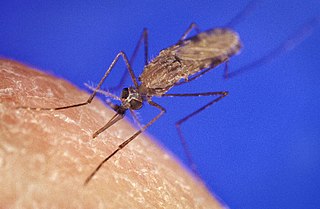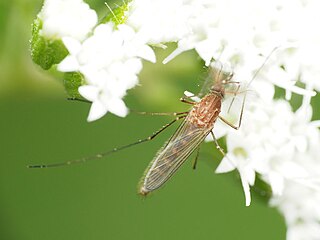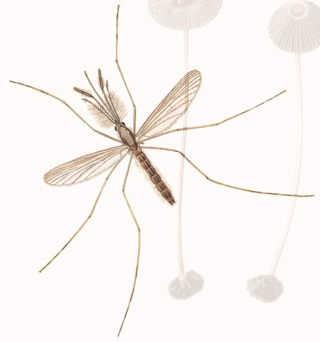
Mosquitoes, the Culicidae, are a family of small flies consisting of 3,600 species. The word mosquito is Spanish and Portuguese for little fly. Mosquitoes have a slender segmented body, one pair of wings, three pairs of long hair-like legs, and specialized, highly elongated, piercing-sucking mouthparts. All mosquitoes drink nectar from flowers; females of some species have in addition adapted to drink blood. Evolutionary biologists view mosquitoes as micropredators, small animals that parasitise larger ones by drinking their blood without immediately killing them. Medical parasitologists view mosquitoes instead as vectors of disease, carrying protozoan parasites or bacterial or viral pathogens from one host to another.

Anopheles is a genus of mosquito first described by J. W. Meigen in 1818, and are known as nail mosquitoes and marsh mosquitoes. Many such mosquitoes are vectors of the parasite Plasmodium, a genus of protozoans that cause malaria in birds, reptiles, and mammals, including people. The Anopheles gambiae mosquito is the best-known species of marsh mosquito that transmits the Plasmodium falciparum, which is a malarial parasite deadly to human beings; no other mosquito genus is a vector of human malaria.

The Anopheles gambiae complex consists of at least seven morphologically indistinguishable species of mosquitoes in the genus Anopheles. The complex was recognised in the 1960s and includes the most important vectors of malaria in sub-Saharan Africa, particularly of the most dangerous malaria parasite, Plasmodium falciparum. It is one of the most efficient malaria vectors known. The An. gambiae mosquito additionally transmits Wuchereria bancrofti which causes lymphatic filariasis, a symptom of which is elephantiasis.

Culex (Culex) tritaeniorhynchus is a species of mosquito and is the main vector of the disease Japanese encephalitis. This mosquito is a native of northern Asia, and parts of Africa. Females target large animals for blood extraction, including cattle and swine, and are strongly anthropophilic.

Forensic entomology has three sub-fields: urban, stored product and medico-criminal entomologies. This article focuses on medico-criminal entomology and how DNA is analyzed with various blood-feeding insects.

Culex restuans is a species of mosquito known to occur in Canada, the United States, Mexico, Guatemala, Honduras, and the Bahamas. It is a disease vector for St. Louis encephalitis and West Nile virus. In 2013 West Nile Virus positive specimens were collected in Southern California.

Anopheles is a genus of mosquitoes (Culicidae) with about 484 recognised species.
Rajpal Singh Yadav is an Indian scientist in the field of vector ecology and management. He joined the World Health Organization in 2009. He retired in 2023, as a Scientist at the Department of Control of Neglected Tropical Diseases, Geneva, Switzerland. He was a Co-Chair of the WHO Joint Action Group for the implementation of the Global Vector Control Response,. He was also Head of the WHO Pesticide Evaluation Scheme (WHOPES) for the evaluation of vector control products. During this period he reviewed research protocols and generated a global evidence base for insecticide use and pesticide management. He was also a Focal person in, the WHO secretariat for the FAO/WHO Joint Programme on Pesticide Management. The work involved collaboration with other UN and international organizations, research institutions, programmes, industry, NGOs, and other stakeholders. He is the recipient of the 2016, Lifetime Achievement Award from the Indian Association of Entomologists. He has published more than 100 scientific articles in peer-reviewed journals.

Anopheles albimanus is a species of mosquito in the order Diptera. It is found in coastal Central and South America, the Caribbean, and Mexico. It is a generalist species and capable of wide dispersion. A. albimanus is a common malaria vector.

Anopheles stephensi is a primary mosquito vector of malaria in urban India and is included in the same subgenus as Anopheles gambiae, the primary malaria vector in Africa. A. gambiae consists of a complex of morphologically identical species of mosquitoes, along with all other major malaria vectors; however, A. stephensi has not yet been included in any of these complexes. Nevertheless, two races of A. stephensi exist based on differences in egg dimensions and the number of ridges on the eggs; A. s. stephensisensu stricto, the type form, is a competent malaria vector that takes place in urban areas, and A. s. mysorensis, the variety form, exists in rural areas and exhibits considerable zoophilic behaviour, making it a poor malaria vector. However, A. s. mysorensis is a detrimental vector in Iran. An intermediate form also exists in rural communities and peri-urban areas, though its vector status is unknown. About 12% of malaria cases in India are due to A. stephensi.
Culex modestus is a species of blood-feeding mosquito of the family Culicidae. It has been experimentally demonstrated to be capable of transmitting West Nile virus (WNV), and its habit of feeding aggressively on both birds and humans gives it significant potential for transmission of zoonotic infections from birds to humans. It is believed to be the principle bridge vector of WNV between birds and humans in southern France and is thought to have played a role in WNV transmission in the Danube delta, Caspian and Azov sea deltas, and the Volga region in Russia. It has also been implicated in Tahyna virus and Lednice virus transmission in France and Slovakia, respectively.

Anopheles darlingi, the American malaria mosquito, is a species of mosquito in the family Culicidae. A. darlingi is one of the major species of mosquito known to be responsible for malaria in the Amazonian regions. It has a wide range of geographic distribution that stretches from Mexico and Argentina but it has also been found to populate in areas affected by deforestation and environment changes due to humans.

Anopheles claviger is a mosquito species found in Palearctic realm covering Europe, North Africa, northern Arabian Peninsula, and northern Asia. It is responsible for transmitting malaria in some of these regions. The mosquito is made up of a species complex consisting of An. claviger sensu stricto and An. petragnani Del Vecchio. An. petragnani is found only in western Mediterranean region, and is reported to bite only animals; hence, it is not involved in human malaria.

Anopheles sinensis is a species of mosquito that transmits malaria as well as lymphatic filariasis. It is regarded as the most important vector of these human parasitic diseases in Southeast Asia. It is the primary vector of vivax malaria in many regions. In China it also transmits the filalarial parasite, and arthropod roundworm. In Japan it is also a vector of a roundworm Setaria digitata in sheep and goats.
Culex vishnui is a mosquito belonging to the Culicidae family. It is the most common vector (carrier) of the Japanese encephalitis virus (JEV) in India, Sri Lanka, Thailand, and Sarawak.
Anopheles (Cellia) karwari is a species complex of zoophilic mosquito belonging to the genus Anopheles. It is found in India, and Sri Lanka, Bangladesh, Sumatra, and Java. A. karwari is a member of the Maculatus Group and the second scarcest species reported from Indonesia. Female is blood sucking and involved in transmitting Plasmodium falciparum, thus an important malarial vector. It is considered a secondary vector in the Australian region, but its vectorial status in South-East Asia was unknown.

Anopheles freeborni, commonly known as the western malaria mosquito, is a species of mosquito in the family Culicidae. It is typically found in the western United States and Canada. Adults are brown to black, with yellow-brown hairs and gray-brown stripes on the thorax. Their scaly wings have four dark spots, which are less distinct in the male.

Anopheles atroparvus is a European species of mosquito, which was first identified in 1927. It is one of the most abundant palearctic Anopheles species belonging to the family Culicidae, commonly called mosquitoes. Although research interest in A. atroparvus has been low in the past several decades, recent concern for an increase in vector-borne disease has encouraged new research into this species.

Anopheles hermsi is a species of mosquito in the family Culicidae. It is a known vector of Plasmodium vivax malaria. An. hermsi have been collected in Southern California.
Rampa Rattanarithikul is a Thai entomologist and taxonomist. She is a leading expert on mosquitoes, having discovered 24 new species and identifying at least 420 during her career. She was the lead author of the six-volume Illustrated Keys to the Mosquitoes of Thailand. The mosquito species Anopheles rampae and Uranotaenia rampae are named for her.












